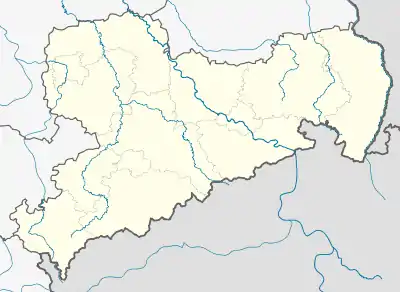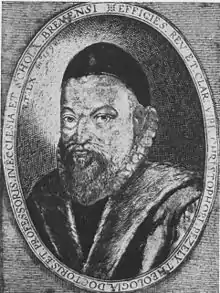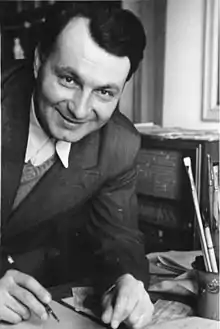Plauen
Plauen (German pronunciation: [ˈplaʊ̯ən])[2][3] is a town in the Free State of Saxony, east-central Germany. It is the capital town of the district Vogtlandkreis. The town is situated near the border of Thuringia, Bavaria and the Czech Republic.
Plauen | |
|---|---|
 Panoramic view over Plauen | |
 Coat of arms | |
Location of Plauen within Vogtlandkreis district  | |
 Plauen  Plauen | |
| Coordinates: 50°29′N 12°07′E | |
| Country | Germany |
| State | Saxony |
| District | Vogtlandkreis |
| Subdivisions | 5 town boroughs with 38 parts |
| Government | |
| • Lord mayor | Ralf Oberdorfer (FDP) |
| Area | |
| • Total | 102.11 km2 (39.42 sq mi) |
| Elevation | 412 m (1,352 ft) |
| Population (2019-12-31)[1] | |
| • Total | 64,597 |
| • Density | 630/km2 (1,600/sq mi) |
| Time zone | UTC+01:00 (CET) |
| • Summer (DST) | UTC+02:00 (CEST) |
| Postal codes | 08523;-5;-7;-9 |
| Dialling codes | 03741 |
| Vehicle registration | V, AE, OVL, PL, RC |
| Website | www |
History
Plauen was founded by Polabian Slavs in the 12th century as "Plawe" and was passed to the Kingdom of Bohemia in 1327. The town was captured by the Archbishop of Magdeburg, Lippold von Bredow, in 1384. In 1466, it was passed to Albertine Saxony and later in 1569 to the Electorate of Saxony. Plauen became incorporated into the Kingdom of Saxony in 1806 during the Napoleonic Wars.
In the late-19th century, Plauen became a centre of textile manufacturing, specializing in Chemical lace, called Plauen lace. Around 1910, Plauen, as an industrial 'boomtown' of the region, reached its population peak (1910 census: 121,000, 1912: 128,000).
In the 1930s, Plauen hosted the first chapter of the Nazi Party outside of Bavaria. Plauen's population, however, has shrunk dramatically since the Second World War (1939: 111,000 inhabitants). It was occupied by American troops on 16 April 1945 but was left to Red Army on 1 July 1945.
From 1945 onwards, Plauen fell into the Soviet occupation zone of Germany, which later became the German Democratic Republic (1949-1990). Plauen hosted a large Red Army occupation garrison and, in the last years of the GDR (DDR), an officer school of the Border Guards ("Grenztruppen der DDR"). The first mass demonstration against the communist regime in the GDR began in Plauen on 7 October 1989; this was the beginning of a series of mass demonstrations across the country and ultimately led to the re-unification of Germany in 1990.
The exposé Fast Food Nation gives special mention to Plauen as the first town of the GDR to have a McDonald's restaurant following the collapse of the Berlin Wall.
In the district reform of 1 July 2008, Plauen lost its urban district status and was merged into the district Vogtlandkreis.
 Plauen downtown
Plauen downtown Plauen old market
Plauen old market Plauen, old townhall
Plauen, old townhall The Church of St. Markus
The Church of St. Markus Vogtlandtheater
Vogtlandtheater Commemorative plaque in Plauen for the mass demonstration of 1989
Commemorative plaque in Plauen for the mass demonstration of 1989
Politics
The first freely elected mayor after German reunification was Rolf Magerkord of the Christian Democratic Union (CDU), who served from 1990 to 2000. The mayor was originally chosen by the city council, but since 1994 has been directly elected. Ralf Oberdorfer of the Free Democratic Party (FDP) has been mayor since 2000. The most recent mayoral election was held on 15 June 2014, with a runoff held on 6 July, and the results were as follows:
| Candidate | Party | First round | Second round | |||
|---|---|---|---|---|---|---|
| Votes | % | Votes | % | |||
| Ralf Oberdorfer | Free Democratic Party | 8,641 | 40.1 | 9,327 | 53.7 | |
| Steffen Zenner | Christian Democratic Union | 7,213 | 33.4 | 8,029 | 46.3 | |
| Uwe Täschner | Green / Left / SPD | 5,711 | 26.5 | |||
| Valid votes | 21,565 | 99.2 | 17,356 | 98.6 | ||
| Invalid votes | 168 | 0.8 | 240 | 1.4 | ||
| Total | 21,733 | 100.0 | 17,596 | 100.0 | ||
| Electorate/voter turnout | 54,227 | 40.1 | 54,214 | 32.5 | ||
| Source: Wahlen in Sachsen | ||||||
The most recent city council election was held on 26 May 2019, and the results were as follows:
| Party | Votes | % | +/- | Seats | +/- | |
|---|---|---|---|---|---|---|
| Christian Democratic Union (CDU) | 20,717 | 23.7 | 11 | |||
| Alternative for Germany (AfD) | 17,464 | 20.0 | New | 11 | New | |
| The Left (Die Linke) | 12,728 | 14.5 | 6 | |||
| Social Democratic Party (SPD) | 12,245 | 14.0 | 6 | |||
| Free Democratic Party (FDP) | 8,687 | 9.9 | 4 | |||
| Alliance 90/The Greens (Grüne) | 7,529 | 8.6 | 3 | |||
| Initiative Plauen (WV) | 4,752 | 5.4 | 2 | ±0 | ||
| The III. Path | 3,366 | 3.8 | New | 1 | New | |
| Valid votes | 30,247 | 98.2 | ||||
| Invalid votes | 556 | 1.8 | ||||
| Total | 30,803 | 100.0 | 42 | ±0 | ||
| Electorate/voter turnout | 52,962 | 58.2 | ||||
| Source: Wahlen in Sachsen | ||||||
Industry and infrastructure
Plauen (Vogtland) Oberer Bahnhof lies on the Leipzig–Hof line. The section of this line through Plauen is part of the Saxon-Franconian trunk line running between Nürnberg, Hof, Plauen, Zwickau, Chemnitz and Dresden. The town had another station, Plauen (Vogtland) Unterer station (now defunct), on the Elster Valley Railway. There is a plan to rename the Oberer (Upper) station into Plauen Hauptbahnhof (Main Station).
Vogtlandbahn (Vogtland Railway), a regional train company, operates services from Plauen to Hof, Werdau, Chemnitz, Zwickau, Falkenstein and Adorf within Germany and Cheb (Eger) in the Czech Republic. At these stations, there are other Vogtlandbahn services to München, Regensburg, Marktredwitz, Dresden and Leipzig within Germany and Karlovy Vary (Karlsbad) and Prague in the Czech Republic. A Vogtlandbahn Express Bus service runs between Plauen and Berlin Schönefeld Airport and Zoological Garden.
The Plauen Straßenbahn is a tramway that has 6 lines connecting the centre of town, Plauen-Tunnel stop, to the surrounding areas and the Oberer railway station.
Main sights

- Embroidery Machine Museum
- Museum Plauener Spitze
- Galerie e.O. plauen
- Old Town Hall
- Elster Viaduct – second largest brick bridge in the world
- Friedensbrücke – largest stone arch bridge in the world
- Johanniskirche
- Old Elster Viaduct – oldest bridge in Saxony
- Malzhaus
Education and science
Plauen is home to a University of Applied Sciences with about 300 students and a DIPLOMA Fachhochschule.
Sport
VFC Plauen
Notable residents
- Heinrich von Plauen (1370–1429), Grand Master of the Teutonic Knights

- Christoph Pezel (1539–1604), theologian
- Johann von Mayr. (1716–1759). Prussian general
- Ferdinand Gotthelf Hand (1786–1851), philologist
- Eduard Friedrich Poeppig (1798–1868), botanist, zoologist and explorer
- Gustav Hartenstein (1808–1890), philosopher
- Charles Beyer (1813–1876), locomotive designer and engineer
- Emil Kautzsch (1841–1910), theologian
- Arwed Rossbach (1844–1902), architect in Leipzig
- Hermann Vogel (1854–1921), illustrator
- Kurt Helbig (1901–1975), weightlifter
- Friedrich Hielscher (1902–1990), religious philosopher, writer and resistance fighter against Nazism

- E.O. Plauen (1903–1944), cartoonist
- Paul Wessel (1904–1967), politician (SED)
- Egon Zill (1906–1974), Nazi SS commandant of the Flossenbürg concentration camp

- Werner Hartenstein (1908–1943), war-time commander of U-156, notable for the RMS Laconia (1921) incident
- Walter Ballhause (1911–1991), photographer
- Johannes Kuhn (born 1924), Protestant theologian
- Horst Dohlus (1925–2007), SED functionary
- Karl Richter (1926–1981), conductor, organist, and harpsichordist
- Hans Otte (1926–2007), composer and pianist
- Klaus Zoephel (1929–2017), composer and conductor
- Klaus Zink (born 1936), football player
- Angelika Bahmann (born 1952), Olympic champion and world champion in canoe slalom
- Kornelia Ender (born 1958), Olympic champion swimmer
- Andrea Stolletz (born 1963), handball goalkeeper
- Olaf Schubert (1967), comedian and musician
- Frank Meyer (born 1969), television presenter
- Martin Dulig (born 1974), politician (SPD)
- Christian Bahmann (born 1981), world champion in canoe slalom
- Christin Zenner (born 1991), swimmer
Honorary citizens
- Martin Mutschmann, 1933 (revoked 1945)[4]
Twin cities
 Aš, Czech Republic, since 1962
Aš, Czech Republic, since 1962 Steyr, Austria, since 1970
Steyr, Austria, since 1970 Hof, Germany, since 1987
Hof, Germany, since 1987 Siegen, Germany, since 1990
Siegen, Germany, since 1990 Cegléd, Hungary, since 2005
Cegléd, Hungary, since 2005 Pabianice, Poland, since 2006
Pabianice, Poland, since 2006 Šiauliai, Lithuania, since 2010
Šiauliai, Lithuania, since 2010
Twin cities of Jößnitz (urban district)
 Heilsbronn, Germany
Heilsbronn, Germany
Notes
- "Bevölkerung des Freistaates Sachsen nach Gemeinden am 31. Dezember 2019". Statistisches Landesamt des Freistaates Sachsen (in German). July 2020.
- Krech, Eva-Maria; Stock, Eberhard; Hirschfeld, Ursula; Anders, Lutz Christian (2009). Deutsches Aussprachewörterbuch (in German). Berlin: Walter de Gruyter. p. 828. ISBN 978-3-11-018202-6.
- Mangold, Max (2005). Das Aussprachewörterbuch (in German) (6th ed.). Mannheim: Dudenverlag. p. 635. ISBN 9783411040667.
- Miller 2017, p. 341.
References
- Miller, Michael (2017). Gauleiter Volume 2. California: R James Bender Publishing. ISBN 1-932970-32-0.CS1 maint: ref=harv (link)
External links
 Plauen travel guide from Wikivoyage
Plauen travel guide from Wikivoyage- Official website
 (in German)
(in German)

